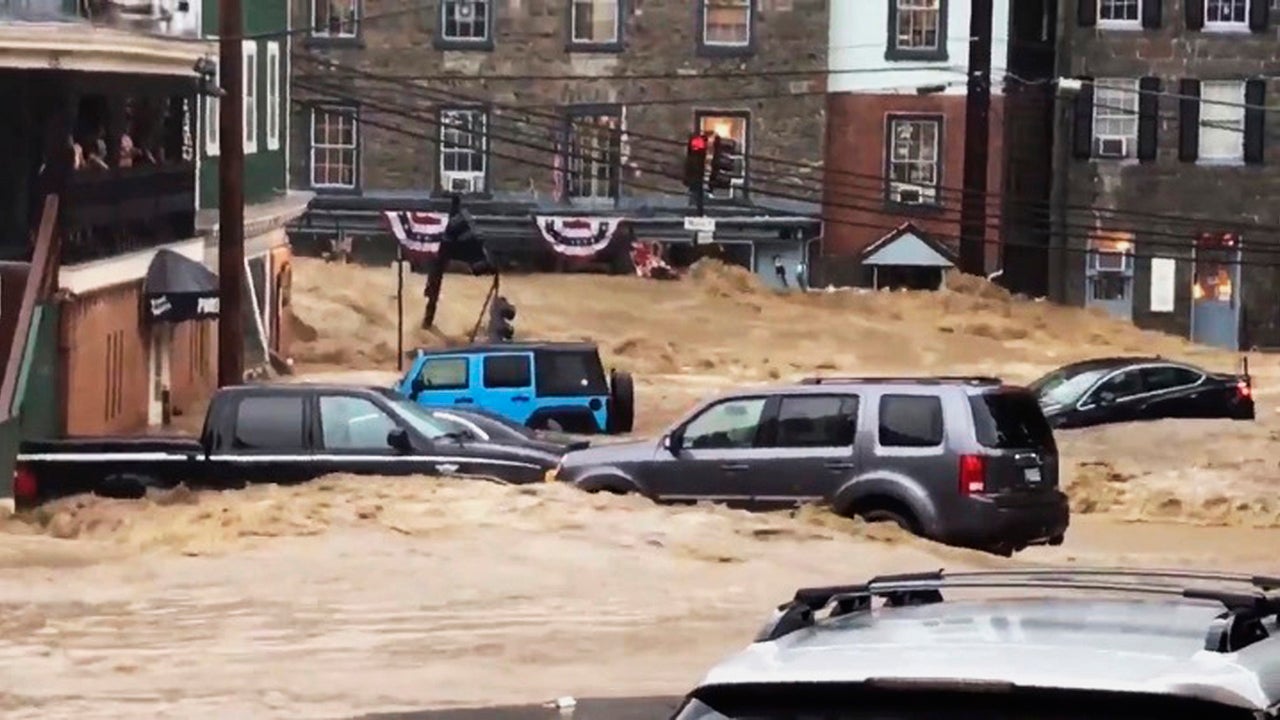Understanding Flash Flood Emergencies: A Comprehensive Guide

Table of Contents
What are Flash Floods?
Flash floods are characterized by a rapid and significant rise in water levels in a short period, often with little or no warning. This distinguishes them from regular floods, which typically develop more slowly over days or even weeks. The speed and intensity of the water's rise are the defining features of a flash flood, making them particularly dangerous.
Several factors can trigger these catastrophic events. Intense rainfall, often associated with thunderstorms or hurricanes, is a primary cause. However, other events such as dam failures, levee breaches, or rapid snowmelt in mountainous regions can also lead to flash floods.
Geographic Areas Prone to Flash Floods
Certain geographic areas are inherently more susceptible to flash flood emergencies than others. These high-risk areas often share common characteristics:
- Areas with steep slopes and little vegetation: Rainfall runs off quickly without the absorption provided by vegetation, leading to rapid water accumulation in lower-lying areas.
- Urban areas with inadequate drainage systems: Concrete and asphalt surfaces prevent water absorption, increasing runoff and overwhelming drainage systems.
- Dry riverbeds and canyons: These areas can channel large volumes of water quickly, resulting in sudden and powerful flash floods.
- Areas with history of flash flooding: Past occurrences indicate a higher likelihood of future events due to geographical factors and weather patterns. Flood plains, in particular, are prone to flooding. Mountainous regions, due to their steep terrain and rapid runoff, are also high-risk areas for flash floods.
Recognizing the Signs of an Impending Flash Flood Emergency
Being aware of the warning signs is crucial in mitigating the risks associated with flash flood emergencies. Recognizing both visual and auditory cues can provide precious time to take protective actions.
Visual cues include rapidly rising water levels in streams and rivers, and water overflowing its banks. You might also notice unusually fast-moving water, even in normally calm areas.
Auditory cues are equally important. A sudden increase in the rushing sound of water, or a change in the usual flow of a river or stream, can indicate imminent danger.
Utilizing Weather Alerts and Forecasting Tools
Staying informed is paramount. Utilize weather alerts and forecasting tools to monitor potential flash flood threats. Websites like the National Weather Service (NWS) and apps offering weather radar provide up-to-the-minute information. Familiarize yourself with the difference between a flash flood watch (conditions are favorable for flash flooding) and a flash flood warning (flash flooding is occurring or is imminent).
- Regularly check local news and weather reports.
- Sign up for emergency alerts via SMS or email through your local government or weather service.
- Understand the difference between a watch and a warning; a warning requires immediate action.
Safety Measures During a Flash Flood Emergency
Immediate action is critical once a flash flood warning is issued. Your primary concern is your safety and the safety of your loved ones.
Upon receiving a warning, immediately move to higher ground. Avoid driving or walking through floodwaters, even if they appear shallow. The force of the water can be deceptively strong, sweeping vehicles and people away.
Emergency Supplies and Preparedness
Having an emergency kit is vital for flood preparedness. This kit should include:
- A well-stocked first-aid kit.
- Several days' worth of non-perishable food and water.
- Flashlights and extra batteries.
- A whistle to signal for help.
- Important documents stored in waterproof containers.
Safe Driving Practices During Flash Floods
Driving during a flash flood is extremely dangerous. Flood water driving is often fatal; even shallow water can easily sweep a vehicle away. Remember the mantra: Turn around, don't drown. Never attempt to drive through flooded roads, even if they seem passable. Road closures should always be obeyed.
- Never drive through flooded areas.
- Turn around and find an alternate route.
- If trapped in your vehicle, get out and move to higher ground immediately. If you cannot escape, call for help and stay on the roof of your vehicle if possible.
Post-Flash Flood Recovery and Assistance
Once the immediate danger has passed, the process of recovery begins. This requires careful attention to safety and a methodical approach.
Cleaning Up After a Flash Flood
After floodwaters recede, assess the structural damage to your property. Contact your insurance company immediately to begin the claims process. Avoid contact with floodwaters, as they may be contaminated with sewage, chemicals, and other hazardous materials. Mold and bacteria are significant health risks in flood-damaged structures. Professional help is crucial for water damage cleanup and mold remediation.
- Contact your insurance company immediately to file a claim.
- Document all damage with photos and videos.
- Seek professional help for cleanup and repairs, especially for mold remediation and water damage cleanup.
Governmental and Non-Governmental Aid
Numerous resources are available to assist with post-flash flood recovery. Federal agencies such as FEMA (Federal Emergency Management Agency) provide disaster relief, including financial assistance and temporary housing. The Red Cross and other local non-governmental organizations offer support, including shelter, food, and emotional assistance.
This assistance can be crucial for communities recovering from the devastating effects of a flash flood.
Conclusion:
Understanding flash flood emergencies is crucial for personal safety and community well-being. By recognizing the signs of impending floods, taking appropriate safety precautions, and having a robust emergency plan in place, you can significantly reduce the risks associated with these devastating events. Remember the key takeaways: know the high-risk areas, heed weather warnings, avoid floodwaters, and prepare an evacuation plan. Developing a personal flash flood preparedness plan and staying informed about weather alerts in your area are essential steps. Utilize the information in this guide to better understand and prepare for flash flood emergencies and protect yourself and your community.

Featured Posts
-
 Kak Vyglyadyat Syn I Doch Naomi Kempbell Neizvestnye Fakty O Seme Supermodeli
May 25, 2025
Kak Vyglyadyat Syn I Doch Naomi Kempbell Neizvestnye Fakty O Seme Supermodeli
May 25, 2025 -
 From Plaza To Pavement The Story Of Black Lives Matter Plaza
May 25, 2025
From Plaza To Pavement The Story Of Black Lives Matter Plaza
May 25, 2025 -
 Flash Flood Warning Issued For Bradford And Wyoming Counties Through Tuesday Evening
May 25, 2025
Flash Flood Warning Issued For Bradford And Wyoming Counties Through Tuesday Evening
May 25, 2025 -
 2023 And Newer Porsche Macan Buyers Guide A Comprehensive Overview
May 25, 2025
2023 And Newer Porsche Macan Buyers Guide A Comprehensive Overview
May 25, 2025 -
 Best Of Bangladesh Draws European Investors To Netherlands Event
May 25, 2025
Best Of Bangladesh Draws European Investors To Netherlands Event
May 25, 2025
Latest Posts
-
 Met Gala 2025 The Naomi Campbell And Anna Wintour Feud And Its Potential Consequences
May 25, 2025
Met Gala 2025 The Naomi Campbell And Anna Wintour Feud And Its Potential Consequences
May 25, 2025 -
 Naomi Kempbell I Ee Podrosshie Deti Pravda O Slukhakh S Millionerom
May 25, 2025
Naomi Kempbell I Ee Podrosshie Deti Pravda O Slukhakh S Millionerom
May 25, 2025 -
 Alleged Naomi Campbell Met Gala Ban The Truth Behind The Wintour Rift
May 25, 2025
Alleged Naomi Campbell Met Gala Ban The Truth Behind The Wintour Rift
May 25, 2025 -
 Is Naomi Campbell Banned From The 2025 Met Gala
May 25, 2025
Is Naomi Campbell Banned From The 2025 Met Gala
May 25, 2025 -
 Is Naomi Campbell Banned From The Met Gala 2025 A Look At The Wintour Feud
May 25, 2025
Is Naomi Campbell Banned From The Met Gala 2025 A Look At The Wintour Feud
May 25, 2025
